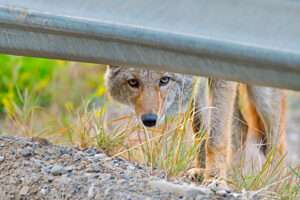What urban wildlife can teach us about cognition, survival and how to be good neighbors.
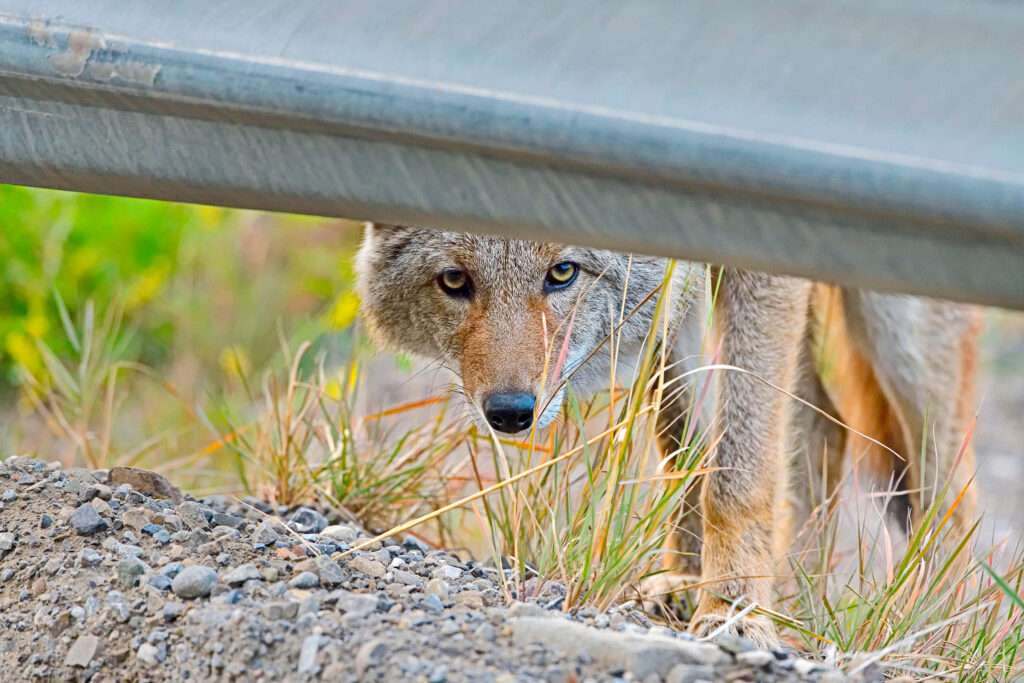
Standing in a thicket of poplars, surrounded by tangled brush and magpie chatter, there’s an air of wilderness. But reminders of the urban world beyond the trees are everywhere: the whir of a passing car, a dog’s bark, a discarded sneaker. “That shoe’s been around for a long time,” says wildlife biologist Sage Raymond. “I have a really cute picture of a coyote pup chewing on that shoe.”
This remnant of forest sits on the sprawling northwestern edge of Edmonton, Alberta, surrounded by two-story, vinyl-sided homes with tidy lawns. At about two hectares (4.5 acres), the pocket park is small enough that we never completely lose sight of the surrounding houses through the leafless, late-winter trees. Yet it’s big enough to hide two coyote dens.
The morning is sunny and uncharacteristically mild for mid-March as we tramp through the crunchy remains of snow, which up until a few days earlier obscured the carpet of dead leaves and was crisscrossed with coyote tracks. We stop in front of a small tree with an odd contraption strapped to its trunk. It’s made of a section of white plastic pipe anchored to a piece of lumber by a long bolt that the pipe can rotate around like a propeller blade. The pipe is sealed on the bottom end with duct tape and filled with dog treats.
It’s a puzzle of sorts, one that Raymond designed to test the coyotes’ problem-solving abilities as part of her PhD work at the University of Alberta. To solve it, coyotes need to rotate the pipe with a nose or paw until the treats spill out. She peers into the top of the pipe. “No treats!” An animal has solved the puzzle. She unlocks a motion-triggered trail camera strapped to a nearby tree and begins scanning the videos on its small screen to see who figured it out. After about a minute, she sighs: “It was probably this squirrel.” Squirrels usually get the treats by chewing through the duct tape. Mice sometimes dive into the top of the pipe, eating the treats and then exiting via small holes near the bottom—which Raymond made, presciently, as rodent escape hatches. She returns every few days to restock the treats.
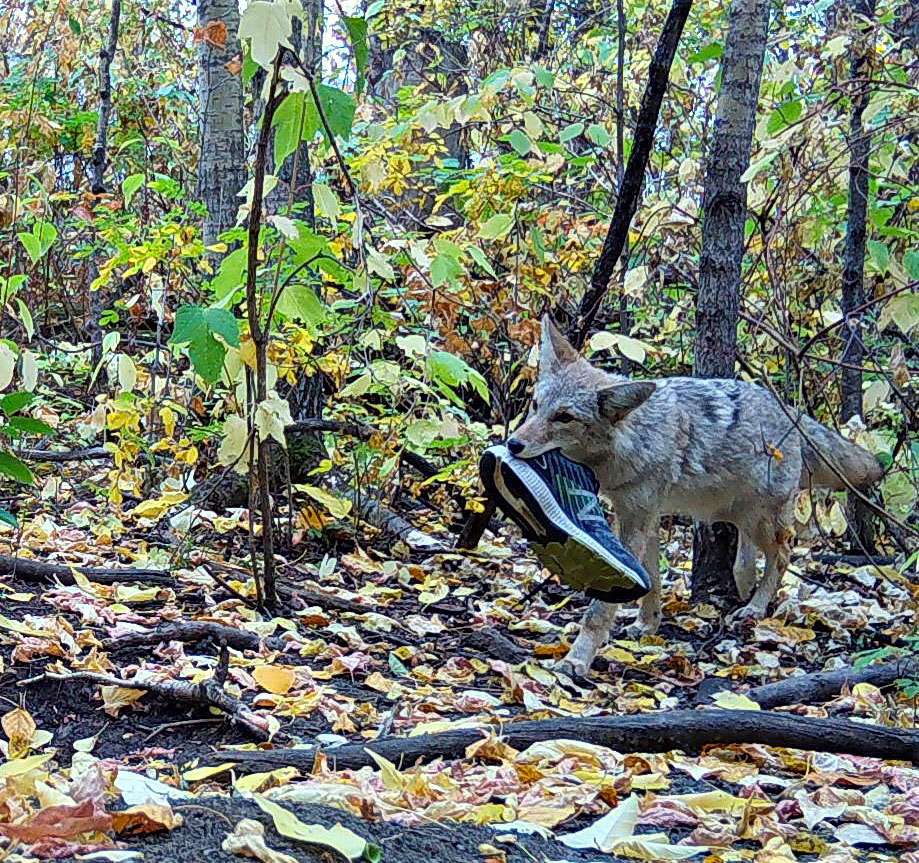
During Raymond’s previous visit to the pocket park, the treats had been missing as well. Now she starts scanning older videos to see who may have solved the puzzle that time. Soon she finds what she’s hoping for: A pair of coyotes emerges from the dark, two white ghosts with eyes illuminated by the camera’s infrared light. The female approaches first and taps the top of the pipe with her nose, causing it to swing a little. Then the male coyote creeps forward, cautiously sniffing the pipe and investigating the ground around the puzzle.
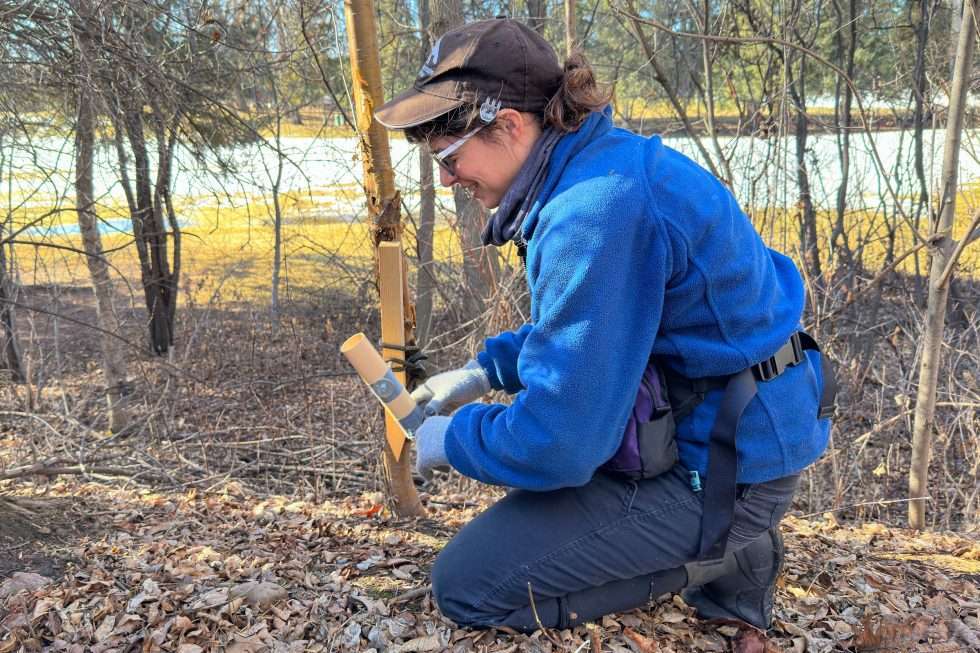
“He’s probably smelling my footprints,” Raymond says.
He approaches the camera, filling the frame with a curious eye. His rapid sniffing briefly drowns out the hum of early evening traffic on a nearby highway. He circles back, tail tucked, stretching his neck toward the pipe. He pokes the top, then the bottom. He pulls on the top with his teeth. It swings, but not quite far enough to spill the treats. He raises a paw and pushes the pipe to the side, briefly getting his teeth around the top before letting go.
“That’s exciting! It’s very few animals that have actually used a paw,” she says.
Then, with the side of his snout, the coyote pushes the bottom of the pipe up to the side, like he’s moving the hour hand on a clock. It’s nearly horizontal when the video inconveniently ends, cut off by the camera’s 20-second timer. At the start of the next clip, he’s hustling away, the tube still swinging on its bolt. With no other potential culprits caught on video, Raymond is confident the coyote solved the puzzle.
Raymond was initially unsure whether notoriously wary coyotes would interact with her puzzles at all. Video courtesy of Sage Raymond
The experiment is part of an expanding field of animal behavior research aimed at understanding how, when urbanization is threatening so many species, some animals—such as coyotes, racoons, and crows—are surviving, and even flourishing, in cities and towns. “You can think of the urban environment as a bit of a problem to solve relative to the environment that coyotes evolved in,” Raymond says. She’s hoping her research will provide clues to how coyotes are learning to solve that problem in Edmonton, where reports of bold behavior around humans are on the rise. “Understanding that might help us better understand certain trajectories that lead to human-coyote conflict.”
With more habitat lost every year to growing cities, and two thirds of the world’s population expected to reside in urban areas by 2050, up from just over half today, people and animals are increasingly sharing space. That proximity brings with it the potential for more conflict, lending urgency to research like Raymond’s. Insight into the minds and lives of the animals that have learned how to live around us could help us learn to be better neighbors to them. And accepting peaceful coexistence as a shared responsibility might even help us be better neighbors to other people as well.
In winter 2024, Raymond deployed the pipe puzzles for four weeks at a time at 26 sites across Edmonton, and 14 more at Elk Island National Park, about 50 kilometers (30 miles) east of the city. By comparing the results from the two locations, Raymond hopes to understand if there are cognitive differences between urban coyotes and their counterparts living in more natural settings. During the first round of deployments, her cameras captured 461 videos of coyotes; 140 of those showed coyotes displaying interest in a puzzle or interacting with it in some way. The experiment is ongoing, but patterns are already emerging. “We’re finding that urban coyotes are a lot bolder,” she says. “They’re much quicker to approach puzzles. They are less fearful of them.”
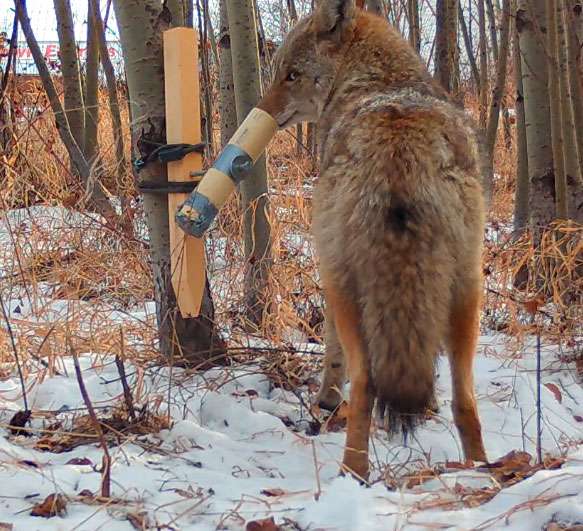
In 13 of those 140 interactions, the coyotes successfully solved the puzzle. While that may sound unremarkable, Raymond wasn’t initially sure the notoriously wary canids would be willing to interact with the puzzles at all. Notably, each of the 13 instances took place in the city. “It seems that this willingness to approach and explore is critical,” says conservation behaviorist Colleen St. Clair, Raymond’s advisor at the University of Alberta. “You can’t get food from a novel source unless you’re willing to approach it.”
Raymond isn’t sure yet whether the park coyotes were unable to solve the puzzles, or if the animals were just too cautious to persist long enough. The results from this year’s puzzle deployments may answer that question, but there are already clues. Test locations in the city ranged from less developed places—like the middle of golf courses with a lot of forested cover—to areas with more roads, buildings, and people, such as the neighborhood pocket park or a thin, forested strip between industrial yards. Coyotes across the city showed similar willingness to investigate the puzzles. But, tellingly, the majority of coyotes who successfully solved puzzles did so in the most urbanized sites.
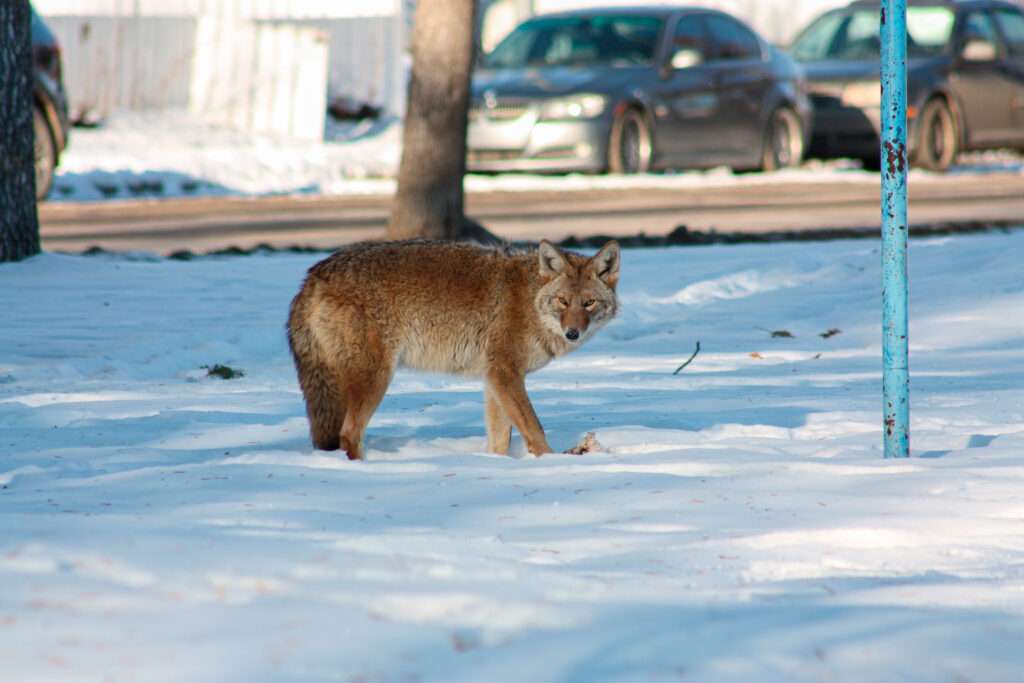
Though many urban species lived on the landscape long before we developed it, people still tend to think of them as pests who’ve invaded our space—as interlopers who should be evicted. But scientists increasingly think of these animals as intriguing research subjects who can help answer key questions about existing, and coexisting, in urban landscapes: What makes them succeed where so many other species have not? And what makes some animals within a species more successful than others? “Is there something that allows these individuals to occupy the sorts of changeable environments that they might find in urban areas?” asks behavioral ecologist Alex Thornton of the University of Exeter in Penryn, U.K., who studies small Eurasian crows called jackdaws.
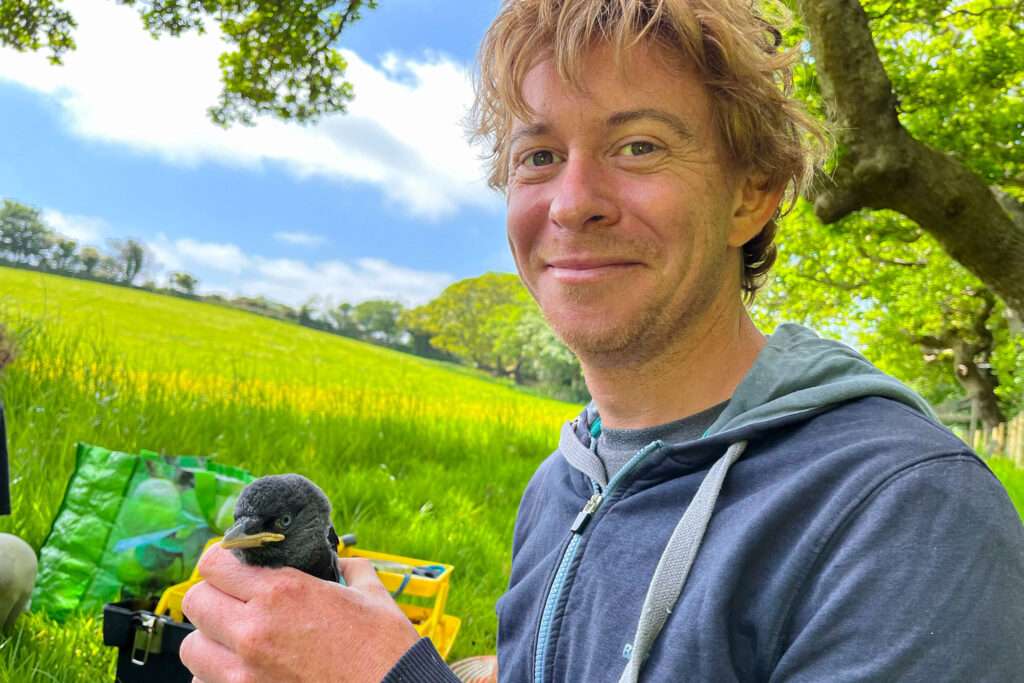
One theory holds that it comes down to how urban animals think: The ability to quickly adjust their behavior to complex and constantly changing surroundings filled with unpredictable humans may act as a buffer against unexpected challenges. “Learning is a big one that we think is important for animals in urban environments, as well as cognitive and behavioral flexibility,” says Lauren Stanton, a cognitive ecologist at the University of California, Berkeley who studies urban raccoons.
Traditionally, scientists have tried to determine what animals’ minds are capable of by devising laboratory experiments to test them in captivity. This approach has the benefit of control: Researchers can keep every aspect of the experiment consistent while testing their subject’s reaction to a single changing variable. But captivity has major, often negative, impacts on animals’ behavior, limiting the conclusions scientists can draw. And the studies provide little insight into how animals actually live their lives in the wild.
Researchers like Raymond, Thornton, and Stanton are helping pioneer a different approach: testing the cognition of wild animals on their own turf, in ways that reflect the real challenges of living in urban environments. As Stanton puts it: “How can we test them in the places that they live, with questions that matter?”
Getting to know the minds of the animals in our midst has several potential benefits. It could show us how to minimize conflict between humans and urban wildlife, and could also answer intriguing scientific questions about how animals think and use their cognitive abilities to adapt to rapidly changing environments. What scientists learn might even change the way we think about the animals sharing our space—and our relationships with them.
“The hope is that by looking more and observing more and examining more of the animals around us and the spaces that we coexist in, that we get a better appreciation,” says Chris Schell, an urban ecologist at UC Berkeley, “not only of the animals, but of ourselves.”
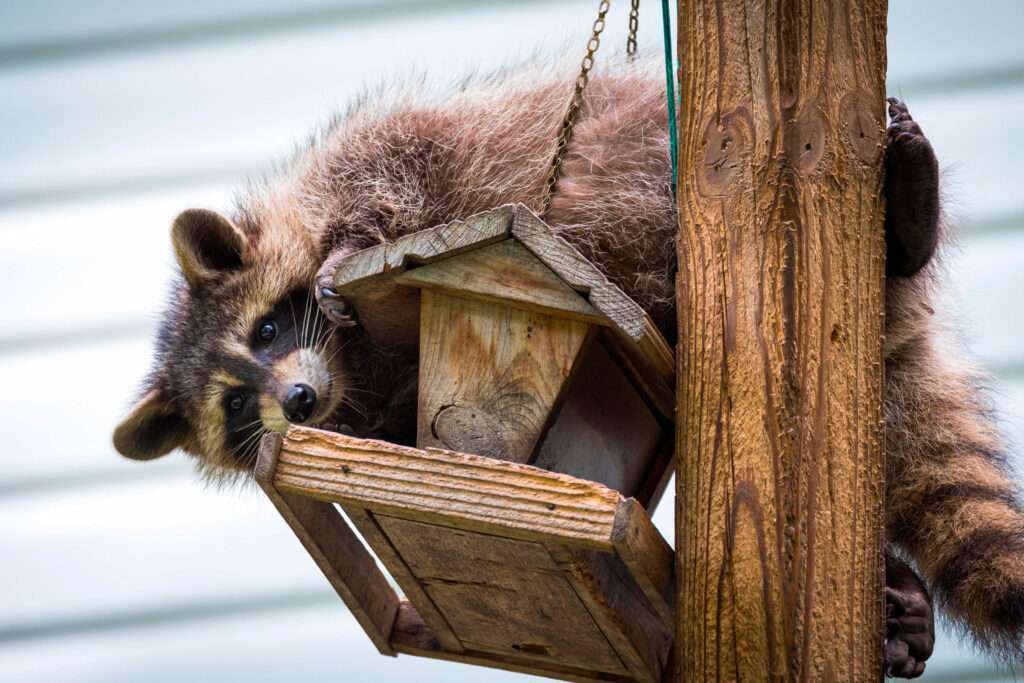
On a crisp December afternoon in 2022, Schell heads down a narrow walkway alongside a mid-century cabin-style home in California’s Berkeley Hills with a spectacular view of the San Francisco Bay. Stanton, who is a postdoctoral researcher in Schell’s lab, shouts from ahead, “It’s open!” At her feet, in the shade of small laurel trees, lies a short section of black plastic pipe with an open cap attached by a rope lying next to it.
The pipe is one of dozens of puzzles, similar to Raymond’s in Edmonton, that Stanton and Schell have deployed to test the cognition of raccoons in the area. To access the dog treats stuffed inside this puzzle, an animal must pop off the tightly fitted cap with a good tug on the rope or pry it off using teeth or claws.
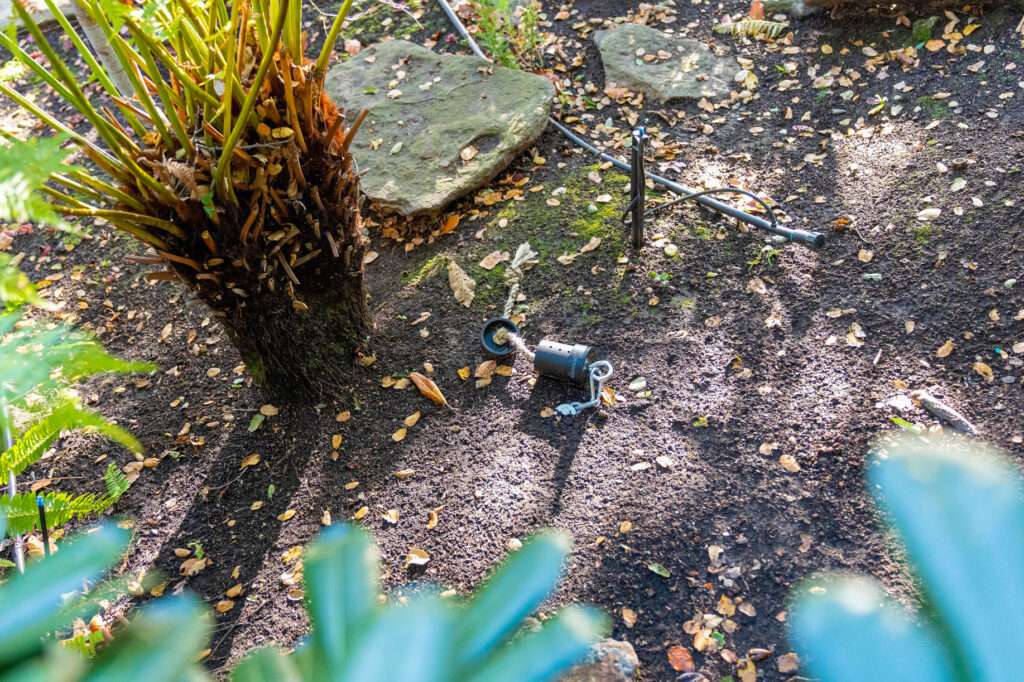
Schell retrieves the memory card from a camera aimed at the puzzle, and Stanton inserts it into a laptop to review the videos. This is their first day checking puzzles, and they aren’t sure yet if the experiment is going to work. The previous stops were disappointing. The first puzzle, tucked in a secluded corner of a semi-public park, had been discovered by a boy, maybe 10 years old, who had immediately opened the pipe with a quick yank on the rope. The second puzzle, in the front yard of a house, was also open, but the memory card was filled with videos of fern fronds waving in the wind
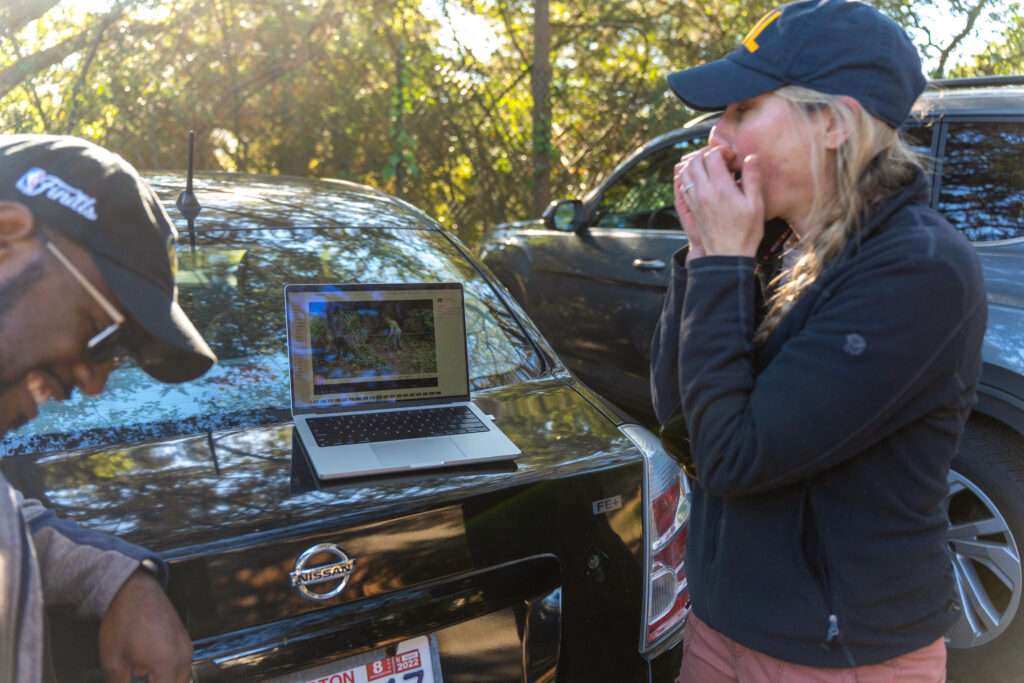
At their third stop, in this Berkeley backyard, the scientists are optimistic but anxious as Stanton clicks through the videos. Schell eagerly looks on: “Big money, big money, no whammies. Here we go!”
Stanton calls out the animals in each clip. “Okay. Cat. Cat. Skunk. Rat. Possum. Possum. Possum!”
“Possum!” Schell echoes. “I wouldn’t have guessed possum.”
In a series of videos, a chubby opossum ambles up to the puzzle, sniffs it thoroughly, pushes it around, and then repeatedly bites the pipe crossways, inching toward the cap until it pops off. Schell is pleased. “That’s one way to solve it!”
Their main target is raccoons, which are ubiquitous in the Bay Area and have dexterous paws that are great for manipulating objects. But Stanton tried to design the puzzle so that various midsized mammals would be physically capable of solving it, in hopes of making some comparisons between species. The rope was added with coyotes and foxes in mind—animals that wouldn’t be able to grip the pipe with their claws but could pull the rope with their teeth. The puzzle also needed to be difficult enough to provide a cognitive challenge, but not so tough that it wouldn’t be frequently solved. And then the scientists just had to cross their fingers that animals would be intrigued enough to give it a try.
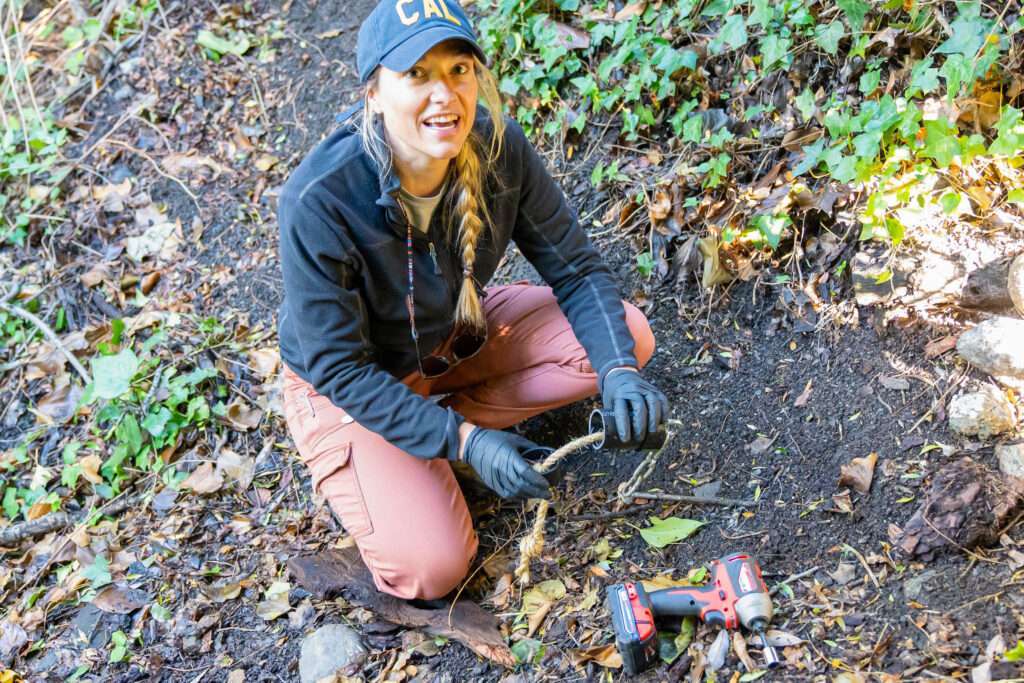
Stanton staged puzzles for one or two weeks each at 124 locations across the eastern side of the bay: in the hills and on the flats, in parks, in wooded areas, and in backyards. The cameras recorded over 200 species, including deer, squirrels, bobcats, birds, and otters. Six species solved at least one puzzle: raccoons, coyotes, opossums, red foxes, striped skunks, and domestic cats. (Dogs also solved the puzzle, but only cats are included in the study because they are usually free-ranging.)
“Animals like raccoons and striped skunks and opossums seem to interact with the puzzle right away. They’re very interested in it,” Stanton says. “But of those three species, raccoons are the puzzle champions.” Over the course of the two-year experiment, animals solved the puzzles around 70 times. Raccoons were responsible for more than half of those successful encounters, solving them in just about every imaginable way: They pulled the rope with teeth or paws, pried the contraption open with claws, bit off the cap. In one video, two raccoons working on a puzzle together employ pretty much all those strategies until they succeed, then contentedly munch on the rewards.
Raccoons work to open one of Stanton’s puzzles. The data should provide insights into the ways raccoons and other species manage to thrive in a city environment. Video courtesy of Lauren Stanton and Chris Schell
The study builds on Stanton’s previous research examining problem-solving and learning among urban raccoons in Laramie, Wyoming, and on earlier work by comparative psychologist Suzanne MacDonald at York University in Toronto that found urban raccoons were better than their rural cousins at extracting food from garbage cans with secured lids. The current study’s primary goal is to learn more about how raccoons and other species are dealing with the various challenges of urban life, Schell says. “How are they solving the city? What are the strategies that they’re employing in order to get around, survive, and persist in environments that we dominate?”
But the raccoons’ willingness to give the puzzles a go also means the researchers may have enough data to explore what effects specific aspects of city life may have on the animals. The urban environment varies greatly in terms of green space, density of people, traffic, pollution, and more. By studying their behavior in many locations across that diverse landscape, the researchers hope to learn how different environmental factors may impact raccoons’ cognition and behavior.
“Understanding how the behavior of these animals varies across the landscape tells us a lot about how the landscape is perceived by them,” Schell says, “but also how we can start creating and building better, more wildlife-friendly—and human-and-wildlife-friendly—cities.”
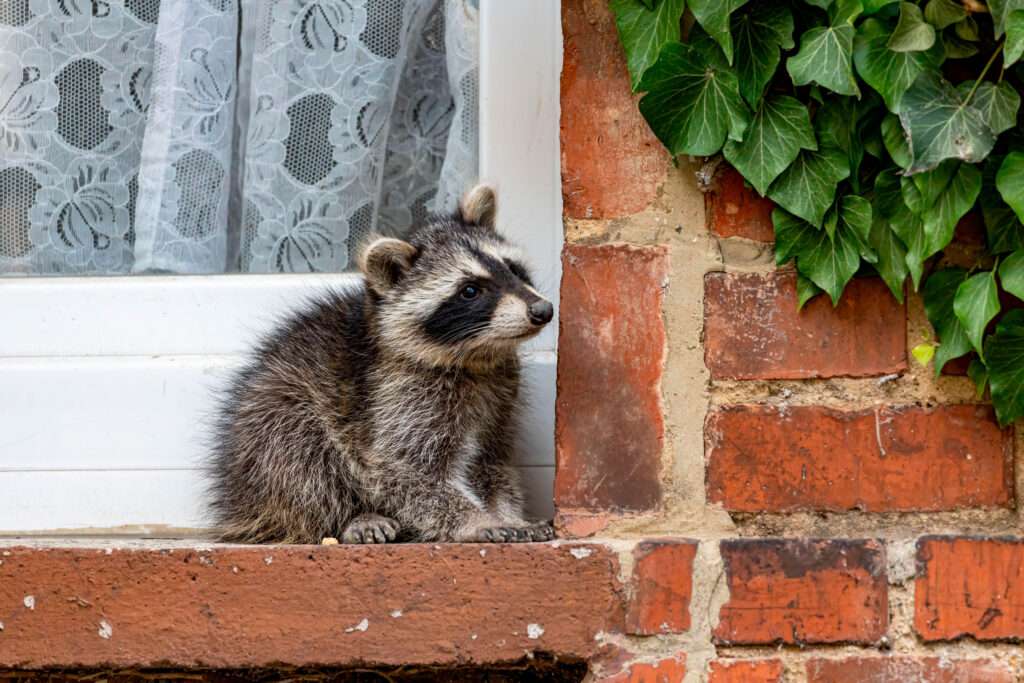
While raccoons and coyotes are helping scientists understand how cognition varies across the urban landscape, jackdaws offer a unique opportunity to ask more specific questions about the ways individual animals are managing to live among humans. “We do a lot of work trying to understand how the jackdaws respond to people, because people are their biggest threat,” says Thornton, the University of Exeter researcher. Although human-caused threats have sent avian populations around the globe plummeting, many species in the corvid family—which includes crows, ravens, and jackdaws—are increasing in urban areas. “And that seems to be largely because they’re super innovative,” he says.
Visit any European city or town, and you’ll probably encounter jackdaws: small black crows with silvery nape feathers and pale gray eyes. One reason for this urban pervasiveness is their nesting behavior. While most corvids build their nests high up in trees or on cliff ledges and away from other birds, jackdaws nest in colonies and prefer sheltered spots like tree hollows, rock crevices—and even chimneys. If a jackdaw builds a nest in your chimney, it can be noisy, messy, and difficult to remove, which is illegal in the U.K. until the chicks have fledged. But this vexing habit also makes them great study subjects; they happily build nests in boxes set up by Thornton’s team.
Plenty of research has shown that corvids are brainy birds capable of the kinds of complex cognition previously thought to be exclusive to primates—like planning for the future and using tools. But most of those studies were conducted in the lab on captive birds, Thornton says. “So they don’t really tell us anything about why these animals are so smart.”
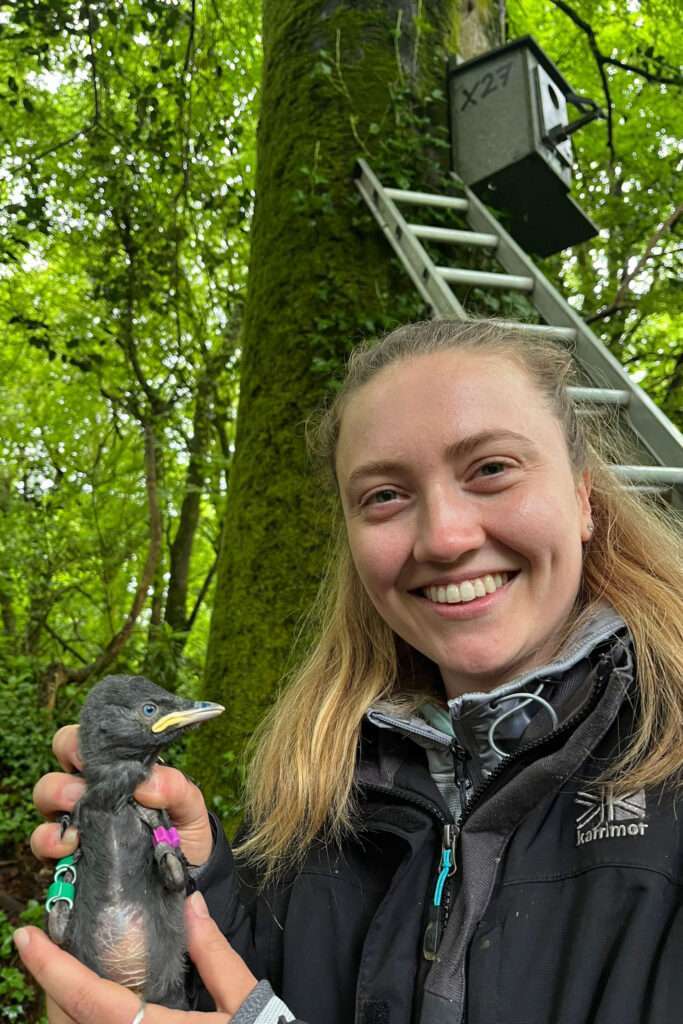
To answer that question, Thornton started the Cornish Jackdaw Project in 2012. Since then, his team has studied three colonies, installing an average of 30 nest boxes for each. The boxes allow scientists access to microchip the chicks, attaching tiny rings to their legs before they leave the nest. Chip readers then log every time a bird visits a box, and cameras spy on the birds’ home lives. This gives Thornton’s team the ability to gather lots of data on individual animals. Crucially, they can track the breeding outcomes of pairs of jackdaws and connect that to birds’ individual performance on cognitive tests to see which traits improve their ability to survive and reproduce. This helps reveal which abilities contribute to jackdaw success in urban areas. “We basically have a kind of ‘Big Brother’-style surveillance system going on,” he says.
One goal of the research is to understand how jackdaws think about the people around them. Studies of wild crows and ravens have shown that they can recognize and remember people’s faces for years. The same may be true for jackdaws. Behavioral ecologist Guill McIvor, now at the University of Vienna in Austria, helped establish the project and has personally ringed most of the more than 4,000 birds involved in the research. He noticed that in one of the colonies with nest boxes on a farm near the Cornish village of Stithians, jackdaws reacted differently to specific people. As soon as they glimpsed McIvor—someone who was always poking around their nests, handling eggs and chicks—the birds would leave their nest boxes and scold him from nearby trees. But the farm’s owner, Paul Gluvas, could engage in really loud, disruptive work—such as pressure-washing a trailer—just below a nest box, and the birds would carry on feeding their chicks like nothing was happening.
“The jackdaws recognize his face,” McIvor says. “They know it’s Paul. They know it’s completely benign.” This inspired an experiment that found that the birds in the farm colony were also more likely to flee from male voices than female. One possible explanation is that jackdaws connect lower frequencies with larger, potentially more dangerous individuals. But it might have been based on the jackdaws’ own experiences, McIvor says. “At the time, the only people who had been bothering the birds at the nest boxes were male.”
As time went on, most of the birds in the study colonies learned that the scientists were harmless. The ability to recognize which people are threats may be one of the keys to the birds’ success in urban areas. They can learn to avoid people who have bothered them in the past while not fleeing from friendly people, McIvor says, leaving more time to care for their chicks.
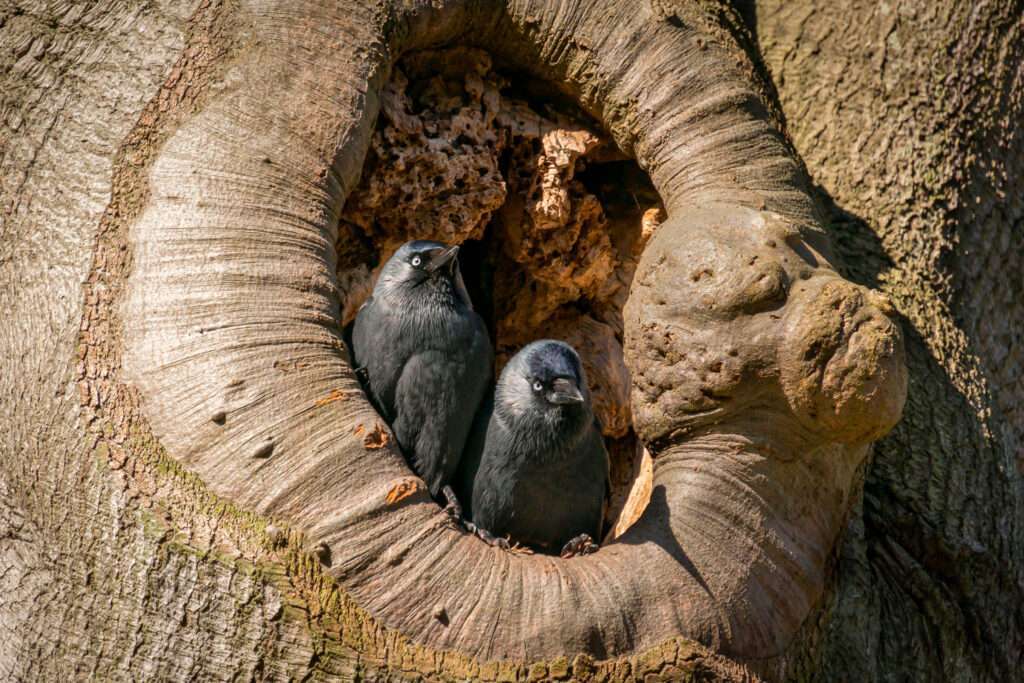
Flexible thinking may also be crucial to how jackdaws survive in unpredictable, rapidly changing urban environments. In an experiment published in 2023, Thornton’s team found that jackdaws can strategically adjust their social networks. In one colony in the project, located near a church on the outskirts of Stithians, they set up pairs of feeding stations that could respond to individual birds based on the microchips in their leg bands. The scientists randomly divided the birds into two groups and programmed the feeders to dispense mealworms (a favorite jackdaw treat) only when two birds from the same group visited together. Over four months, they tracked 139 birds and logged more than 3,000 feeder visits. “The idea that you could run a massive social network manipulation and experiment under natural conditions would have been totally implausible 10 years ago,” Thornton says. “But it’s now possible because we have tracking technology that allows us to do this kind of thing.”
Relationships between bonded partners and immediate kin did not change during the experiment, regardless of the mealworms. But beyond those close family ties, jackdaws were socially flexible, increasingly visiting the feeding stations with other members of their assigned groups. “What you see is that the birds will quickly learn to ditch old friends if they’re no longer productive, and form new associations,” Thornton says.
The researchers are currently running experiments to compare the cognition of jackdaws in settings that range from rural to urban, hoping to uncover nuances that might help explain the birds’ success in managing city life. Understanding how they respond to the world around them, including us, could be key to learning how we can best respond to them, Thornton says. “I think that helps in terms of thinking about, how can we minimize disturbance? How can we create situations that are conducive to coexistence?”
One of the ways coyotes successfully coexist with people is by simply not being seen. But this can make them tricky subjects for scientists. Fortunately, Sage Raymond has skills many wildlife biologists don’t: She’s a certified wildlife tracker. “It’s been hugely helpful on this project,” she says.
During the first winter of her coyote research, Raymond estimates she followed more than 500 kilometers (310 miles) of coyote trails across Edmonton. Along the way, she noted areas the animals visited frequently where she could place puzzles so coyotes would be sure to encounter them. She also found a surprising number of coyote dens. She discovered them in neighborhood parks, in ravines, on golf courses, in ditches behind industrial yards, on the side of the highway, and under shipping containers. She even found one den excavated below an abandoned shopping cart lying on its side in a garbage-strewn ditch. “We think that they’re basically selecting sites that are difficult or unpleasant for humans to access,” Raymond says. In total, she located 120 dens—far more than she had expected.
The abundance of dens in Edmonton reflects the remarkable resilience of coyotes. For more than a century, people have tried to eradicate them through hunting, trapping, and poisoning. Despite North Americans killing upwards of 5 million coyotes between 1915 and 1971, the canids have never come close to extinction. The persecution continues today, with some U.S. states offering bounties and organizing hunting contests. But attempts to reduce coyote populations through culling don’t work—and can even backfire. “I think there’s good evidence that it pushes animals to a faster life history,” says Colleen St. Clair of the University of Alberta. “They breed at earlier ages, they produce larger litters, territorial behavior breaks down. All of those things support more coyotes in a smaller space.”
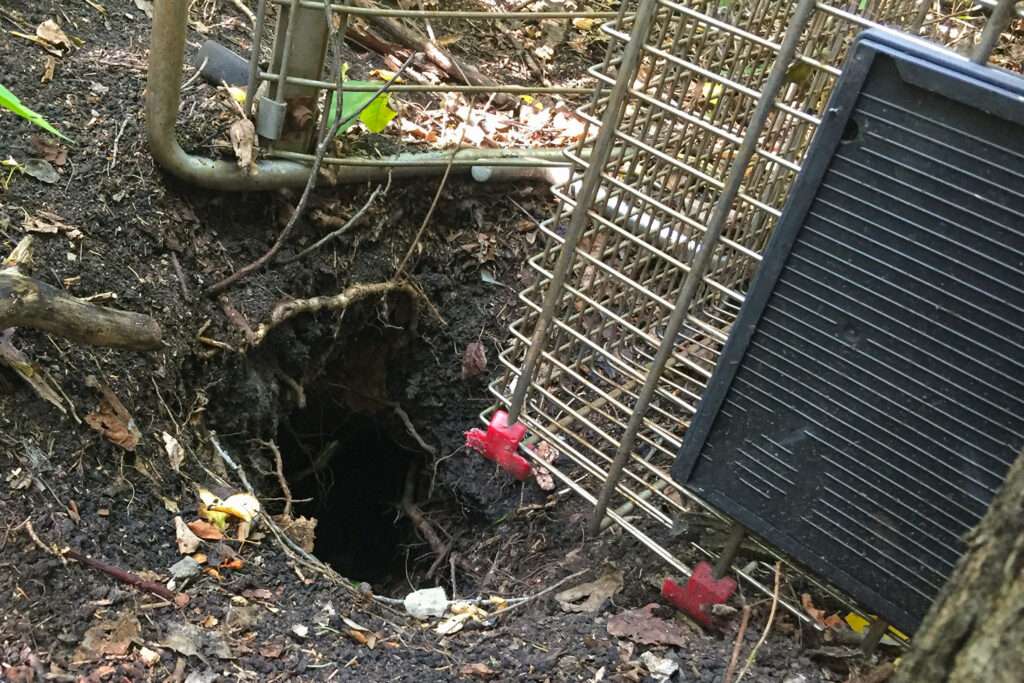
Research in Chicago found that when the city tried to manage urban coyotes through lethal removal, other coyotes quickly reoccupied the vacated territories. “It’s only going to work for a few weeks,” says wildlife ecologist Stan Gehrt of Ohio State University, who studies Chicago’s urban coyotes. “And then you’re going to be right back where you started.” In other words, coyotes are here to stay. Instead of trying in vain to run coyotes out of town, scientists like Raymond and Gehrt think we should learn how to live alongside them.
As urbanization encroaches on more wildlife habitat, the ability to coexist in shared landscapes will be increasingly critical to animals’ survival. “There are fewer and fewer species that are not impacted by humans to some degree,” says behavioral ecologist Sarah Benson-Amram of the University of British Columbia, who studies urban raccoons and coyotes. “So I think the lessons that we’re learning in these urban ecosystems can be really important for conservation.”
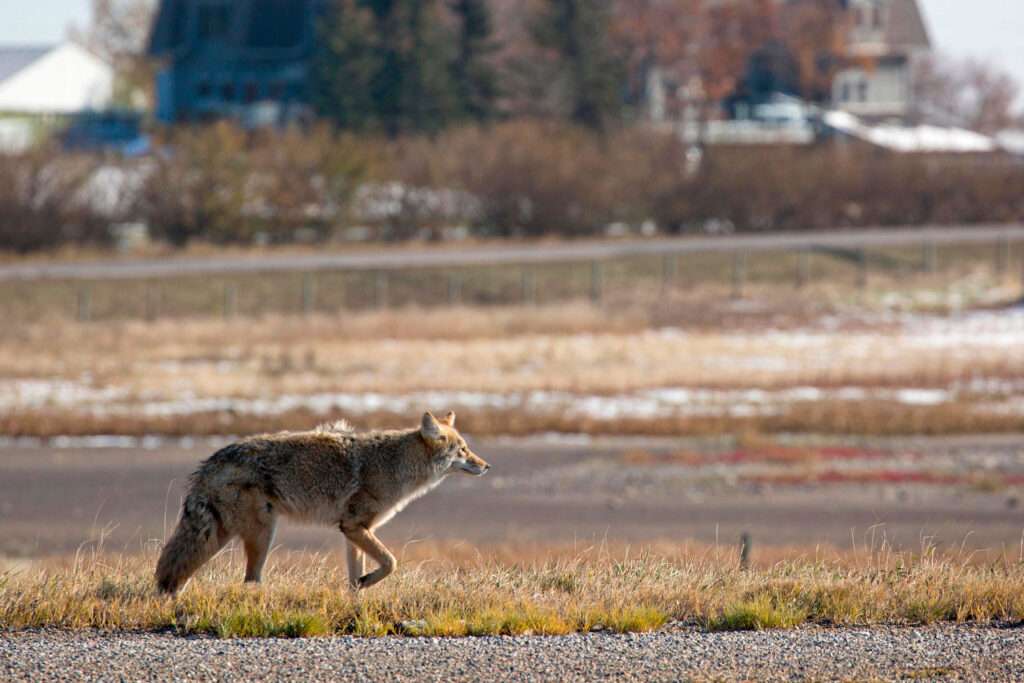
The picture of how animals like coyotes, raccoons, and corvids are thriving in spaces dominated by humans is only just beginning to come into focus. There are likely many factors that contribute to their success, such as being medium- or small-sized—unlike, say, wolves or bears. But what does seem clear is that learning quickly and behaving flexibly is at least part of how animals deal with such complex, rapidly changing environments. “Cognition provides this near-immediate response to solving those problems when they arise,” Schell says.
The same attributes that have helped these animals succeed, however, may also make them more likely to come into conflict with people, Benson-Amram says. The ability to overcome fear of a novel object might mean an animal can exploit a new source of food. But that could involve knocking over someone’s garbage can, raiding their composter, or breaking into their chicken coop. And when we respond by erecting new barriers to keep wildlife out, we’re just giving the animals new problems to solve—which can lead to what Benson-Amram calls an “innovation arms race.” Instead, learning how these animals think and what they need could lead to more effective strategies, she says.
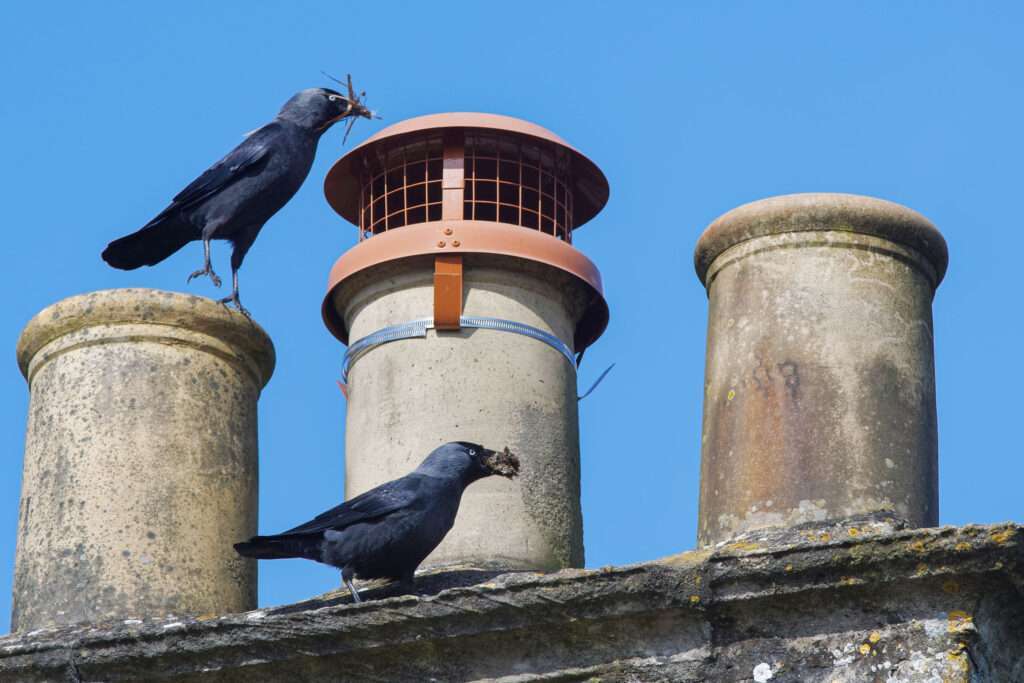
Perhaps that means installing a cage around your chimney to keep jackdaws out while providing a nest box in a nearby tree. In the case of coyotes, St. Clair thinks we can reduce conflict by harnessing the same flexible behavior that enables them to live near us. In Edmonton, she’s trained local volunteers in a technique called aversive conditioning. The idea is for coyotes to learn to connect being too close to people or pets, or being in certain locations during the day, such as schoolyards, with a negative experience, like having sand-filled tennis balls adorned with streamers thrown at them.
Learning more about urban animals’ lives may have benefits beyond better management, Benson-Amram says, such as inspiring more tolerance and empathy. Peaceful coexistence with the wild animals among us might ultimately depend on people shifting their perspective from thinking of them as adversaries or pests to thinking of them as neighbors. The research these scientists are doing could be an important step toward that shift.
Knowledge of the cognitive capabilities of other species has changed how people think about animals before. Scientific findings and documentaries about the complex minds and social lives of dolphins and whales helped turn public opinion against displaying them in aquariums, which resulted in a 2019 ban in Canada against keeping cetaceans in captivity. Research and media coverage revealing that octopuses are capable of problem-solving, playing, and perhaps even forming interspecies friendships prompted some people to quit eating them, and led California and Washington to ban octopus farms last year. Could opening a window into the lives of the animals in our own backyards spark a similar expansion of concern for their well-being?
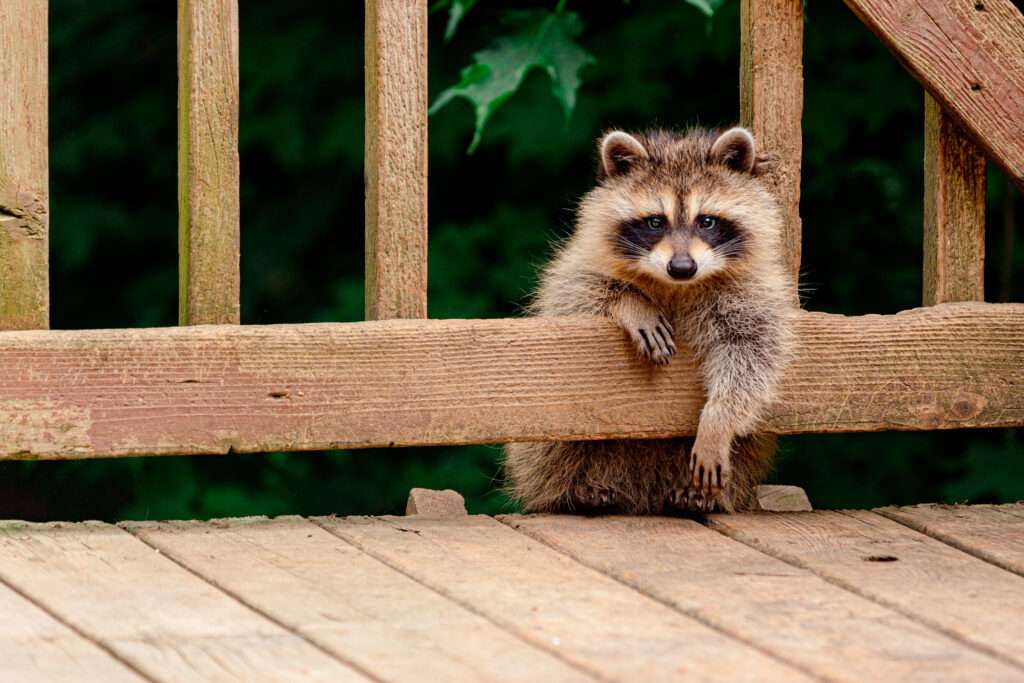
That is certainly the hope,” Schell says. He believes increasing public understanding of urban animals can benefit both animals and people. “One of the guiding principles of the lab is that the work that we do helps us to reimagine how these animals around us live—to pay more respect, more admiration for how gritty they are, but also for us to reconnect to ourselves, to reconnect back to nature, to reconnect back to community,” he says. “Then we start to roll up our sleeves and figure out better ways to coexist with wildlife, and with each other.”
Simply becoming aware that there are coyotes living among us has changed attitudes in Chicago, Gehrt says. Since he began studying them in 2000, he and his colleagues have trapped and put radio collars on more than 700 of the city’s approximately 4,000 urban coyotes. This allowed them to map their population density, revealing that they are everywhere in Chicago, quietly going about their business right under our noses. “I just find it to be an amazing phenomenon every day,” Gehrt says. “Imagine the challenge of having to live in a metropolitan area with millions of people, and you have to avoid them, like every single second of every day. That’s really hard to do.”
Since Gehrt started sharing his maps with the public, he says, complaints about coyotes seem to have decreased, and the city has stopped trying to remove coyotes that aren’t imminent threats to people or pets. “We were able to open up people’s eyes,” Gehrt says. “They’re part of the landscape, even if we don’t know that they’re there.”
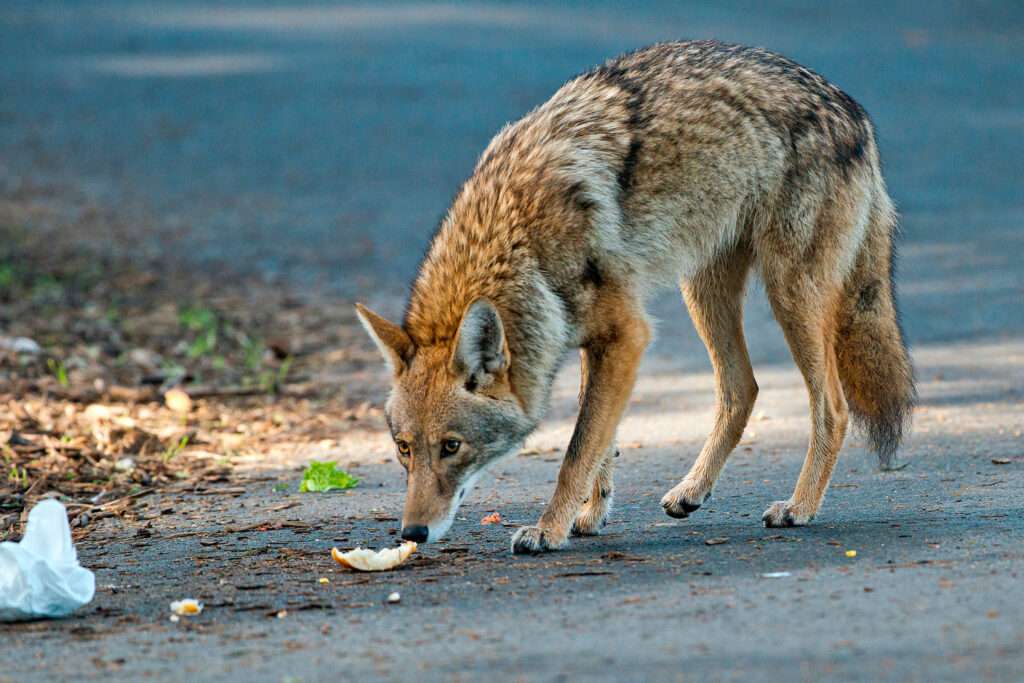
Betsy Mason’s research was supported by an Alicia Patterson Foundation grant. This article first appeared in the March, 2025 edition of bioGraphic.

